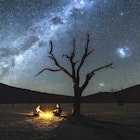
More visitors will be allowed to trek the Wave in Arizona
Jan 13, 2021 • 2 min read

The Wave in Arizona is allowing more visitors © pick-uppath/Getty Images
Arizona's famous and exclusive hike, The Wave, will soon allow more people to trek the colourful sandstone rock formation.
The Wave is situated in the Vermilion Cliffs National Monument, which is located in Arizona, near its northern border with Utah. It got its name because its landscape has been eroded by the wind to resemble an ocean wave. Up to now, the Bureau of Land Management (BLM) capped the number of daily permits at 20 to protect the fragile formation's integrity and beauty, but has decided to increase this number.

In 2018, more than 200,000 individuals applied for the 7300 permits available to take the 9.5km round-trip hike through the Coyote Buttes North section of the park to reach the site, and only 3.6% of applicants were successful. Now it has been announced that a new limit of 64 visitors per day and/or 16 groups per day - whichever comes first - will be permitted to access the Wave from 1 February.
Half of the permits can be reserved online four months in advance through an online lottery that costs a non-refundable $9 (€7.40) per application. The other half are given to walk-in visitors to the visitors' centre in Kanab, on a first come, first served basis at a cost of $7 (€6.26) per person per day and $7 per dog.
However, the increased number of permits raises concerns about sustainability. Prior to making its decision, the BLM noted that allowing more permits would increase the number of encounters with other visitors on the trail, potentially decrease opportunities for solitude, and potentially increase impacts to other resources. “We conducted robust environmental analysis and worked in collaboration with partners and interested stakeholders in an effort to allow more visitors access to the Wave, while maintaining wilderness character,” says BLM Arizona state director, Ray Suazo.
To apply for a permit through the online lottery, please see the website here.
The article was originally published on 15 May 2019 and updated on 13 January 2020.
You might also like:
A guide to hiking the Wave, America's most exclusive trek
The 10 best treks in the world
Pick your peak: discovering Nepal's best trekking regions
Explore related stories







 Activities18 things to do in Grand Canyon National Park that no one should miss
Activities18 things to do in Grand Canyon National Park that no one should missSep 21, 2024 • 9 min read










